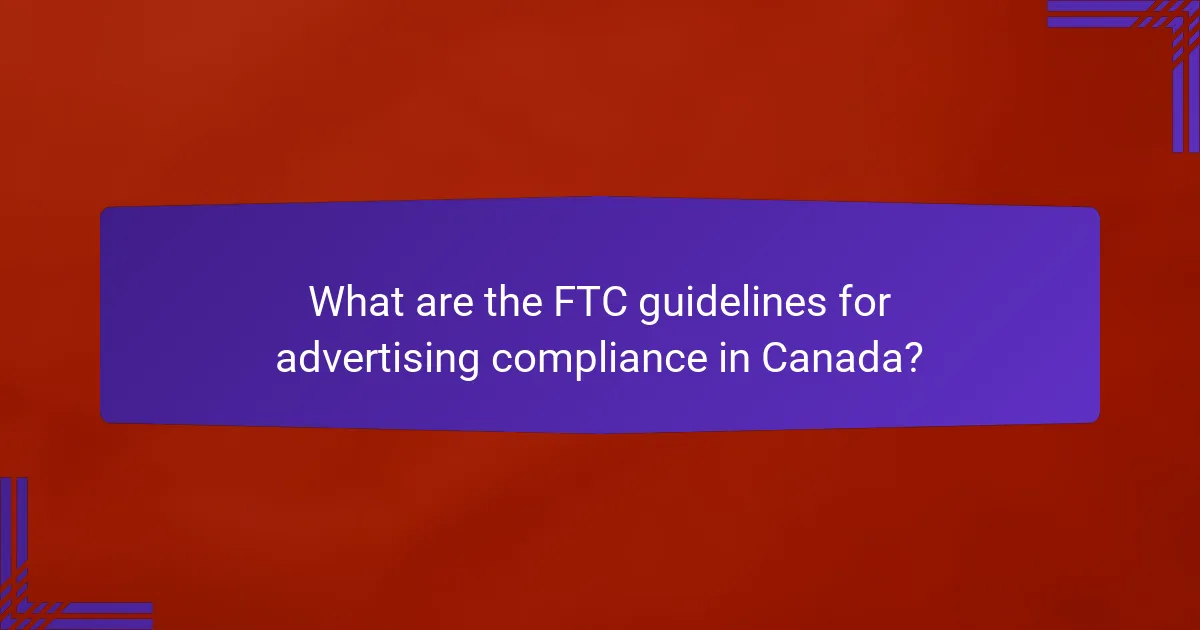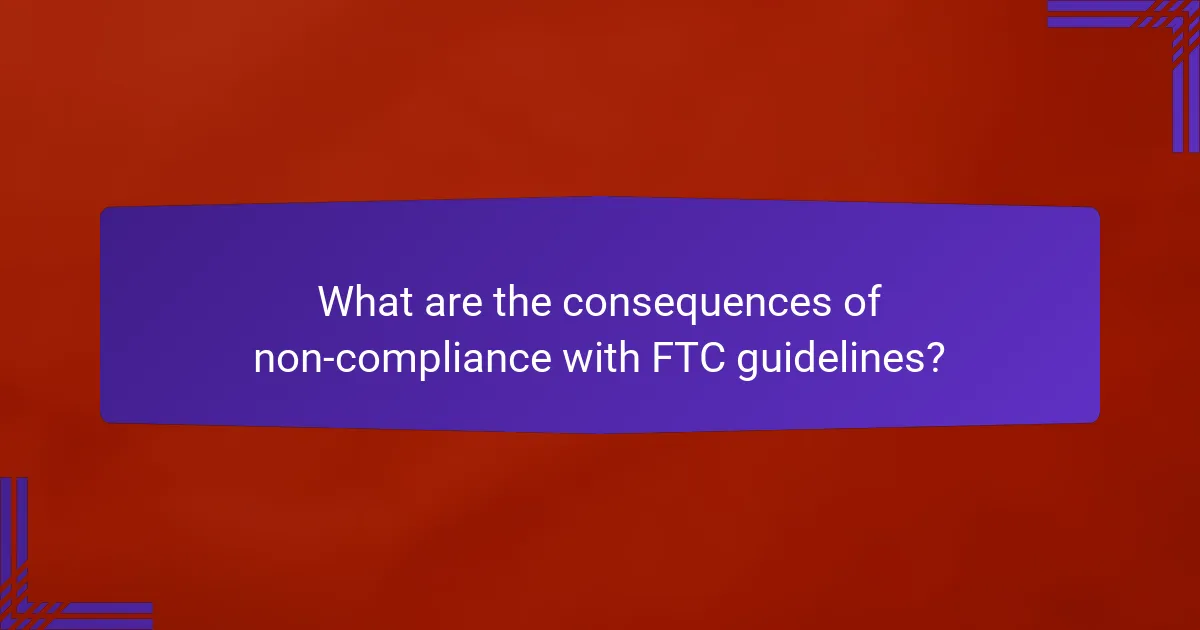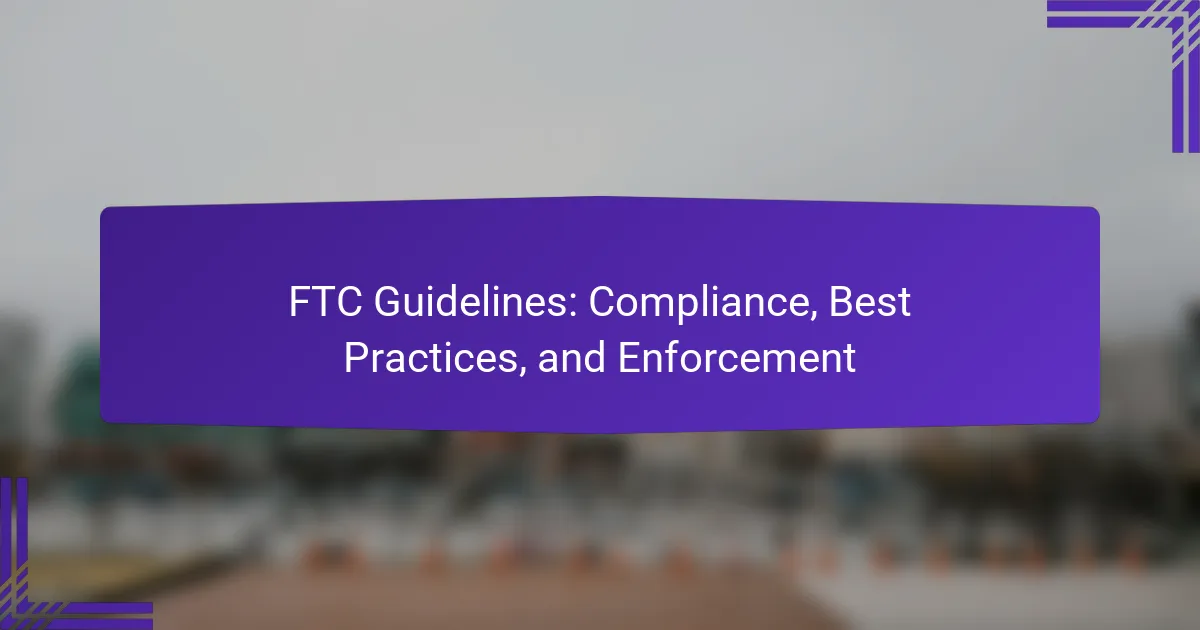The FTC guidelines for advertising compliance underscore the necessity of honesty, transparency, and fairness in marketing practices. To align with these regulations, businesses should implement proactive measures such as regular audits and staff training, ensuring that all claims are truthful and material connections are disclosed. By adhering to best practices, advertisers can foster consumer trust and maintain integrity in their marketing communications.

What are the FTC guidelines for advertising compliance in Canada?
The FTC guidelines for advertising compliance in Canada emphasize the importance of honesty, transparency, and fairness in marketing practices. Advertisers must ensure that their claims are truthful and that any material connections to products or services are clearly disclosed to consumers.
Truthfulness in advertising
Truthfulness in advertising requires that all claims made in advertisements are accurate and not misleading. Advertisers should have adequate substantiation for any claims, especially those related to health, safety, or performance. For example, if a product claims to reduce weight, there must be credible evidence backing that assertion.
To maintain compliance, businesses should regularly review their marketing materials and ensure that all statements reflect the true nature of their products or services. Misleading advertisements can lead to penalties and damage to brand reputation.
Clear disclosure of material connections
Clear disclosure of material connections means that any relationship between the advertiser and the product or service must be made known to consumers. This includes paid endorsements, sponsorships, or any other financial ties. For instance, if a social media influencer promotes a brand they are paid to endorse, they must disclose this relationship clearly.
Using clear language such as “paid partnership” or “sponsored” helps consumers understand the context of the promotion. Failure to disclose these connections can result in enforcement actions by regulatory bodies and loss of consumer trust.
Prohibition of deceptive practices
The prohibition of deceptive practices prohibits any advertising that misleads consumers about a product’s features, benefits, or price. This includes false pricing strategies, exaggerated claims, or hidden fees. For example, if a product is advertised at a certain price but includes additional costs that are not disclosed upfront, it could be considered deceptive.
To avoid deceptive practices, businesses should ensure that all advertising is straightforward and that any terms and conditions are clearly stated. Regular audits of advertising strategies can help identify and eliminate potential deceptive practices before they lead to compliance issues.

How can businesses ensure compliance with FTC guidelines?
Businesses can ensure compliance with FTC guidelines by adopting proactive measures that include regular audits, staff training, and the use of compliance checklists. These practices help identify potential issues and reinforce a culture of adherence to regulations.
Conduct regular audits
Regular audits are essential for assessing compliance with FTC guidelines. These audits should evaluate marketing practices, advertising content, and data handling procedures to ensure they align with regulatory standards.
Consider scheduling audits at least annually, or more frequently if your business undergoes significant changes. Engaging third-party auditors can provide an objective perspective and highlight areas for improvement.
Implement training programs for staff
Training programs for staff are critical in fostering a culture of compliance. Employees should be educated on FTC guidelines relevant to their roles, including advertising standards and consumer protection laws.
Training sessions can be conducted quarterly and should include real-world scenarios to enhance understanding. Providing resources such as handbooks or online modules can help reinforce these concepts and ensure ongoing compliance.
Utilize compliance checklists
Compliance checklists serve as practical tools for businesses to ensure they meet FTC guidelines consistently. These checklists can cover various aspects, such as advertising claims, disclosures, and data privacy practices.
Creating a checklist tailored to your specific business operations can simplify the compliance process. Regularly updating the checklist to reflect changes in regulations or business practices is crucial for maintaining adherence to FTC standards.

What are the best practices for advertising under FTC guidelines?
Best practices for advertising under FTC guidelines focus on ensuring transparency and honesty in marketing communications. Advertisers should prioritize clear disclosures, maintain integrity in endorsements, and regularly monitor their advertising channels to comply with regulations and build consumer trust.
Use clear and conspicuous disclosures
Clear and conspicuous disclosures are essential for compliance with FTC guidelines. Advertisers must ensure that any material connections, such as sponsorships or paid promotions, are easily noticeable to consumers. This can include using bold text, contrasting colors, or placing disclosures at the beginning of an advertisement.
For example, if a social media influencer is paid to promote a product, they should include a clear statement like “Paid partnership” or “Sponsored” in their post. Disclosures should be placed in a way that consumers cannot miss them, avoiding small print or hidden information.
Maintain transparency in endorsements
Transparency in endorsements is crucial for maintaining consumer trust and adhering to FTC regulations. Endorsers should disclose any financial incentives or relationships with the brands they promote. This applies to both traditional advertising and social media platforms.
For instance, if a celebrity endorses a skincare line, they should clarify if they own a stake in the company or receive compensation for their promotion. This honesty helps consumers make informed decisions and fosters a sense of credibility in the endorsement.
Monitor advertising channels regularly
Regular monitoring of advertising channels is vital to ensure ongoing compliance with FTC guidelines. Advertisers should routinely review their marketing materials and practices to identify any potential issues or outdated information. This includes checking social media posts, website content, and email campaigns.
Establishing a schedule for audits can help maintain compliance. For example, conducting quarterly reviews of all advertising content can catch discrepancies early and allow for timely adjustments, ensuring that all disclosures and endorsements remain clear and accurate.

What are the consequences of non-compliance with FTC guidelines?
Non-compliance with FTC guidelines can lead to significant legal and financial repercussions for businesses. These consequences can include legal penalties, reputational damage, and injunctions that restrict future advertising efforts.
Legal penalties and fines
Businesses found in violation of FTC guidelines may face substantial legal penalties and fines. These fines can range from thousands to millions of dollars, depending on the severity of the violation and whether it is a repeat offense. For instance, deceptive advertising practices may incur fines that escalate with each infraction.
Additionally, the FTC has the authority to impose civil penalties for violations of specific regulations, which can further increase the financial burden on non-compliant companies. It is crucial for businesses to stay informed about the guidelines to avoid these costly penalties.
Reputational damage
Non-compliance can severely damage a company’s reputation, leading to a loss of consumer trust. When customers learn that a business has engaged in deceptive practices, they may choose to take their business elsewhere, resulting in decreased sales and market share.
Moreover, negative publicity from FTC actions can linger, impacting a company’s brand image long after the initial violation. Businesses should prioritize transparency and ethical marketing practices to maintain a positive reputation in the marketplace.
Injunctions against future advertising
The FTC can issue injunctions that prohibit businesses from engaging in specific advertising practices in the future. These injunctions can limit a company’s ability to market its products or services effectively, hindering growth and profitability.
Injunctions may also require businesses to implement corrective advertising, which can be costly and time-consuming. To avoid such restrictions, companies should ensure their advertising strategies align with FTC guidelines from the outset.

How does the FTC enforce its guidelines?
The Federal Trade Commission (FTC) enforces its guidelines through a combination of investigations, consumer complaints, and collaboration with other regulatory bodies. This multi-faceted approach ensures compliance with consumer protection laws and addresses violations effectively.
Investigative procedures
The FTC employs various investigative procedures to monitor compliance with its guidelines. These include reviewing advertising practices, conducting market studies, and analyzing consumer data. When potential violations are identified, the FTC can issue subpoenas and conduct hearings to gather evidence.
Investigations can be initiated based on consumer complaints, referrals from other agencies, or proactive monitoring. The process may take several months to years, depending on the complexity of the case and the cooperation of the involved parties.
Consumer complaint mechanisms
Consumers can report unfair or deceptive practices directly to the FTC through its online complaint assistant. This tool allows individuals to submit detailed accounts of their experiences, which the FTC uses to identify patterns and prioritize investigations.
Complaints can cover a wide range of issues, including misleading advertising, fraud, and privacy violations. The FTC encourages consumers to provide as much information as possible to facilitate effective follow-up and potential enforcement actions.
Collaboration with other regulatory bodies
The FTC collaborates with various federal and state agencies to enhance enforcement of its guidelines. This includes sharing information and resources with organizations like the Consumer Financial Protection Bureau (CFPB) and state attorneys general.
Such collaboration allows for a more comprehensive approach to consumer protection, as different agencies can address overlapping issues. Joint efforts may include coordinated investigations and public awareness campaigns to educate consumers about their rights and available protections.

What resources are available for understanding FTC guidelines?
To effectively understand FTC guidelines, businesses can utilize a variety of resources, including official websites and industry-specific compliance guides. These tools provide essential information on regulations, best practices, and enforcement actions.
FTC official website
The FTC official website is a primary resource for accessing comprehensive information about federal regulations, guidelines, and enforcement actions. It offers detailed sections on advertising, marketing, privacy, and consumer protection, which are crucial for compliance.
Users can find educational materials, including articles, videos, and webinars that explain the nuances of FTC regulations. Regularly checking the site can help businesses stay updated on any changes or new guidelines that may affect their operations.
Industry-specific compliance guides
Industry-specific compliance guides provide tailored information that addresses the unique challenges and requirements of different sectors. These guides often include case studies, best practices, and checklists that help businesses navigate FTC regulations relevant to their industry.
For example, the financial services industry may have guides focusing on advertising practices and disclosures, while the healthcare sector might emphasize privacy regulations. Utilizing these resources can significantly reduce the risk of non-compliance and enhance overall business practices.
